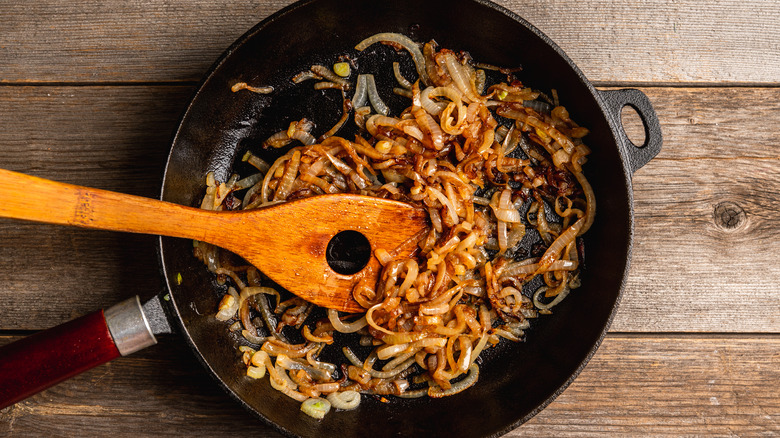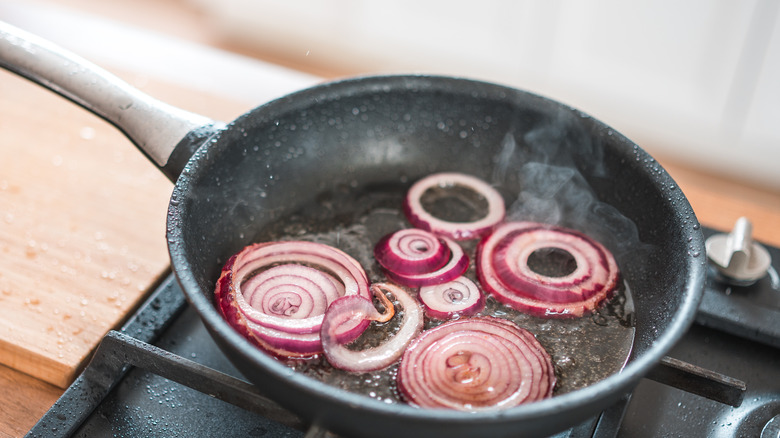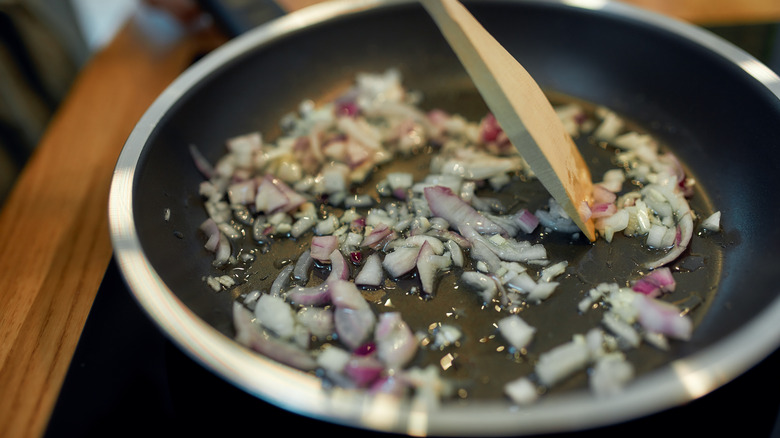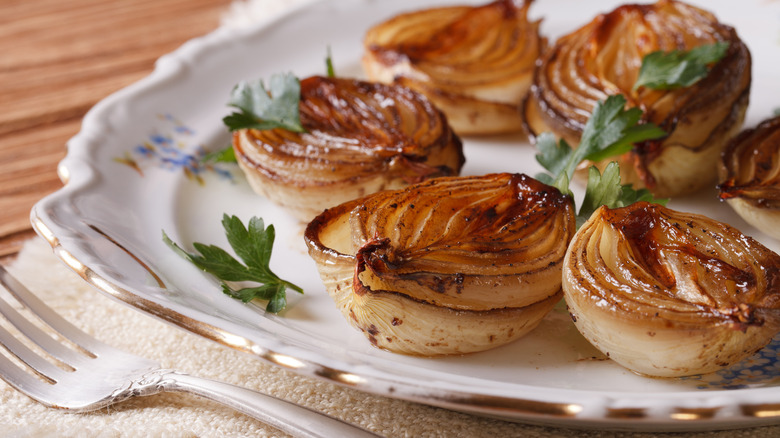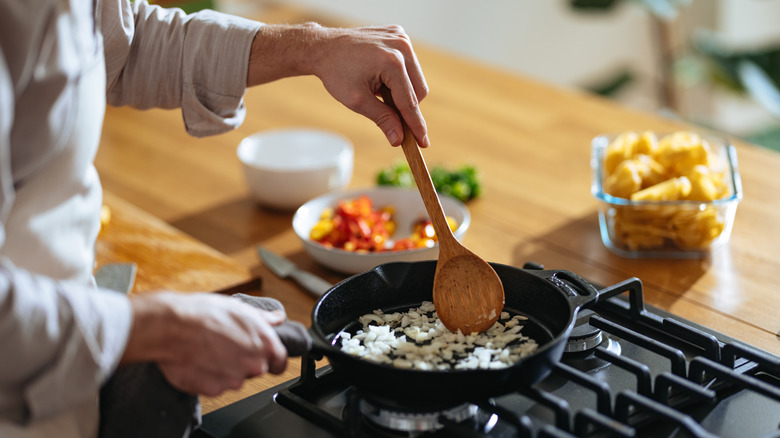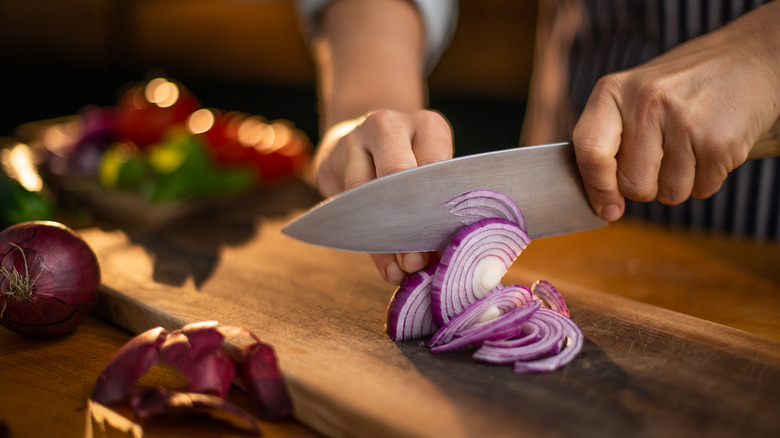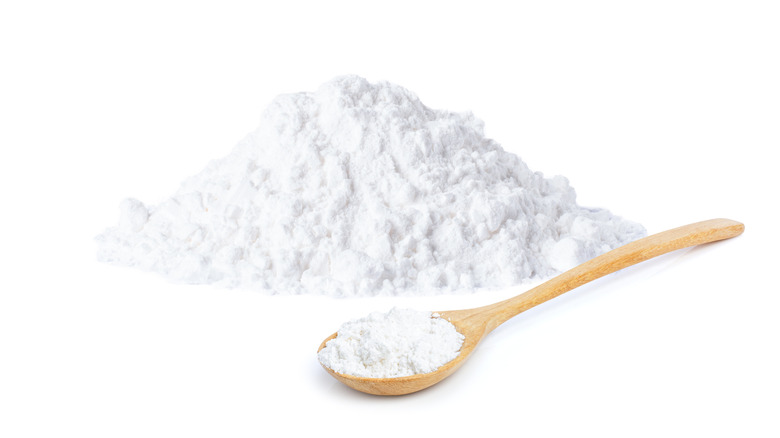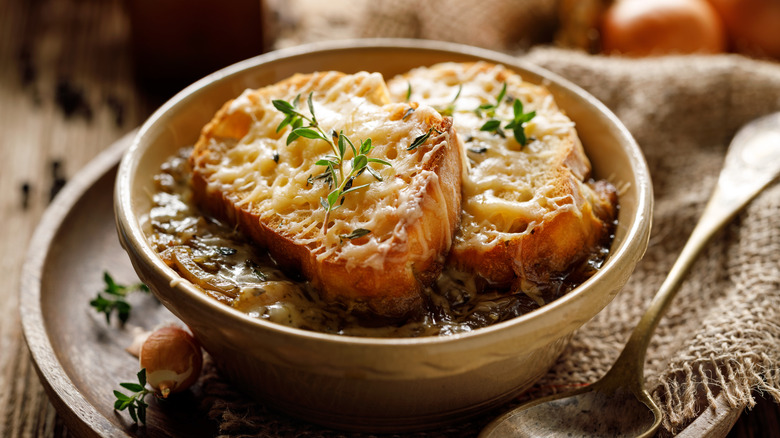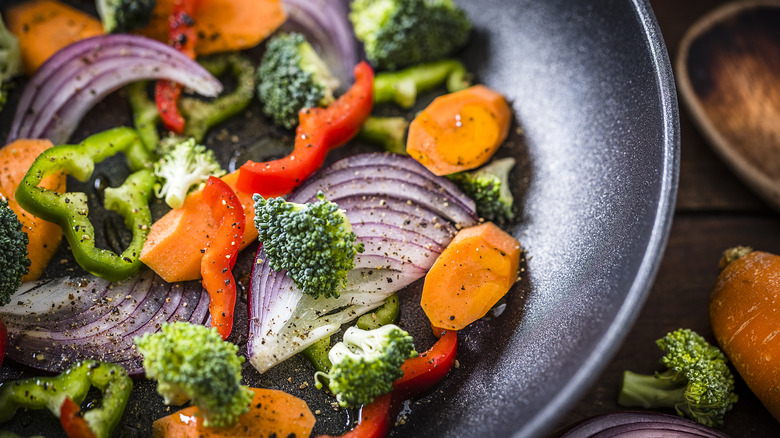Cooked Onions Vs Caramelized Onions: What's The Difference
Sure, onion breath might be scary, but there's a reason these powerful aromatics are a staple worldwide: onions impart different flavors and textures based on how you prepare them. But no matter how you slice them, the transformation from a pungent raw onion to a cooked one is pretty spectacular. From sautéing to grilling to roasting to caramelizing, each method unlocks unique qualities inthis vegetable.
But what differentiates caramelized onions from other types of cooked onions? Do they taste different? Are they cooked differently? And how are they used? This article delves into some of these different cooking techniques to help you understand when to use each method for your dishes' desired flavor and texture. After all, mastering the art of cooking onions can elevate your culinary game. Whether it's a quick sauté or a long caramelization, you'll know how to add depth and complexity to a wide array of dishes.
Browning vs. caramelizing
Browning and caramelizing may seem similar, but they're distinct processes that yield different results. Browning onions, often achieved by sautéing, is a quicker method that also involves what's called the Maillard reaction. This chemical process creates distinct flavors and a savory depth. This chemical process between amino acids and reducing sugars gives browned foods a distinct flavor, enhancing the savory notes of the onions without significant sweetness. Browning is a quicker method and is ideal for dishes that need a rich, umami quality without much sweetness. Caramelizing onions is a slow process where, though the onions brown, the natural sugars break down over low heat, resulting in a sweet, rich flavor profile. This sweetness, unique to caramelized onions, sets them apart from their browned counterparts. Browning is about adding savory notes to dishes, while caramelizing creates a rich sweetness that can transform the overall taste. Browning is perfect for dishes like meaty patty melts or anywhere where you want a robust, oniony flavor.
Sautéing vs. caramelizing
While both methods start the same, sautéing is about softening and lightly flavoring the onions. In contrast, caramelizing is about developing a rich, sweet complexity. You can't really swap one out for the other without changing the flavor profile of your dish. Sautéing onions quickly brings out their natural flavors while maintaining some brightness. To make sautéed onions, cook them in fat (or water) until they're translucent or slightly golden. (What's the secret to perfectly sautéed onions? Some say baking soda.) Sautéing is excellent for when you want a soft texture and a mild onion flavor, such as the base for soups or sauces.
In contrast, caramelizing onions is a more time-intensive process that transforms the onions into a deep brown jam, unlocking a level of sweetness that sautéed onions just don't achieve. This sweetness comes from the slow breakdown of natural sugars over an extended period of low-heat cooking.
Grilling or roasting onions vs. caramelizing
Cooking onions by grilling or roasting them offers a flavor profile that's different from caramelization. When onions are grilled or roasted, they develop a charred, slightly smoky exterior with a still-somewhat crunchy texture inside. If you want to add a smoky flavor to dishes and have a firmer onion texture in them as well, this is a good go-to method. Two fantastic ways to use grilled or roasted onions are in salads or as a standalone side dish. You'll need some top tips if you're planning to roast your onions. These include making sure you use the correct onion — yellow onions are great for this method — and you should consider not removing the onion peel before roasting.
While cooking onions this way lends your vegetable a toasty flavor, it doesn't impart much sweetness. Caramelized onions, however, cook slowly, and their natural sugars intensify to create a sticky, sweet, and soft dish.
Caramelized onions take a long time to cook
Caramelizing onions is a slow process, sometimes taking over an hour to achieve the perfect balance of sweetness and color. The key to caramelizing onions is low and slow cooking, allowing natural sugars to caramelize without burning. To get truly caramelized onions, you need a lot of patience. The process involves regularly stirring the onions to ensure even cooking and prevent burning.
A thick-bottom pan like cast iron is a great place to start. You also need to ensure the pan is big enough for all moisture to evaporate from the onions (that way the caramelization process can start). Slice the onions evenly, heat the pan, then add your fat to the pan before adding onions to it. Coat the onions evenly and begin sautéing low and slow. Remember, your onions can take upwards of an hour to reach that jammy consistency. The longer cooking time allows the sugars to develop a complexity of flavor that is both sweet and savory, making caramelized onions a versatile addition to many dishes.
Change the cut for the texture
The way you cut onions can significantly affect the texture and overall outcome of your dish.When caramelizing onions, cutting against the grain produces a softer texture, as it breaks down the onion's natural structure. This method is ideal for dishes where you want the onions to melt into the background and add flavor without a pronounced texture. On the other hand, cutting with the grain results in a firmer texture, making the onions stand out more in the dish. This technique is great when you want the onions to maintain some bite, such as in stir-fries or as a topping.
How you cut an onion can also influence the caramelization process, with different cuts leading to varying levels of sweetness and texture. For example, you can not only play with whether you cut against the grain but also if you dice or julienne the onions, which plays with the cooking time and depth of flavor. Understanding how the cut affects the final product allows more control over the dish's texture and flavor profile.
Hacks
If you're short on time but crave caramelized onions, try adding a pinch of baking soda, which is a base. This hack speeds up caramelization by altering the pH level of your ingredients, allowing onions to brown faster. It's a great time-saver, letting you achieve sweet, complex-flavored onions in a fraction of the usual time. However, use baking soda sparingly to avoid altering the taste.
Scientists have a few other hacks up their sleeves. Adding sugar to your onions while they cook can save time. If you plan to add sugar, make sure you pick your onions wisely. Regular yellow onions, not sweet ones, work best here. However, choose yellow over red, which don't have enough natural sugar.
But if you're not interested in spending any time over the stove, try a recipe for the easiest overnight caramelized onions. Here you'll let the slow cooker do the work for you, and while it's certainly not quick, the only actual labor you'll be doing is chopping onions.
Caramelized onions work best with...
Even though sweet caramelized onions have a unique flavor, they are versatile and enhance a wide range of dishes. Their sweetness and jammy texture complement rich meats and add a sweet counterpoint to savory elements, making them perfect additions to dishes like burgers, pizzas, and sandwiches. On the vegetarian side of things, try them in quiches, tarts, and pasta. Caramelized onions are a wonderful counterpart to eggs, mushrooms, or any other food with a lot of umami. Their texture is ideal for spreads and dips. Don't underestimate their potential in soups, like French onion soup.
To make a caramelized onion soup recipe, you'll need about four cups of caramelized onions, sour cream, mayo, salt, pepper, and garlic. Mix all the ingredients together and serve with chips. Contrasting the onions with the tart dairy is the perfect way to highlight the onion flavor you've worked so hard to achieve!
Sautéed onions work best with...
Sautéed onions are milder in flavor than their caramelized counterparts. However, they are essential in many dishes. Many of these dishes are the same as those that can be paired with caramelized onions. Still, the sautéed onions will create a different flavor profile, savory and less sweet.
Sautéed onions form the base for soups, stews, and sauces and play nicely with other ingredients. They are also firmer in texture. In stir-fries, sautéed onions add subtle sweetness and bite. They also enhance omelets, sandwiches, and grilled meats, offering a savory topping that complements the main ingredients. You can also use them in French onion soup in conjunction with caramelized ones or on their own. The main thing to remember about sautéed onions is that their versatility and quick preparation make them a go-to for adding flavor without overwhelming a dish with a sweet onion flavor.
